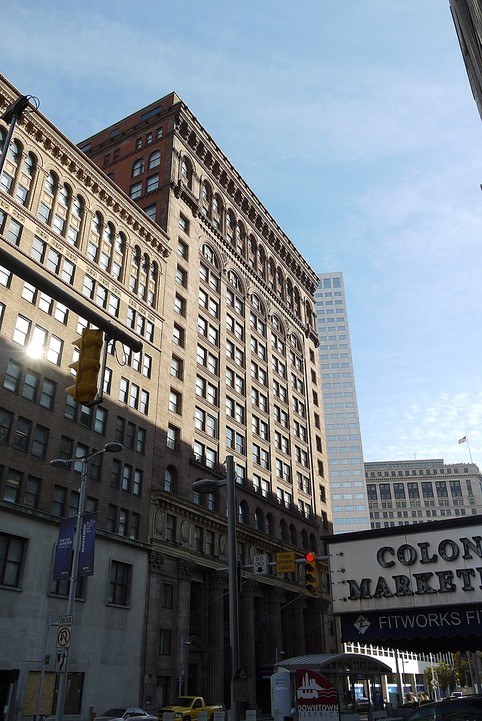New England Building (a.k.a. Guardian Bank Building & National City Bank Building)
Introduction
Text-to-speech Audio
Images
New England Building, also known as Guardian Bank Building and National City Building

Backstory and Context
Text-to-speech Audio
The fifteen-floor New England Building represents a late nineteenth-century urban trend of skyscraper construction, both in Cleveland and throughout the nation. The New England Building arrived during a time when Cleveland enjoyed a business and building boom. When it opened in 1896, it stood as Cleveland's tallest building and one of the highest in the country. The New England name came from its builders, and that name stuck until 1915 when it became the Guardian Building and then later the National City Bank Building.
The building's modern design, along with its status as the city's tallest skyscraper -- a title it held until 1905, inspired several businesses to move their offices to the New England Building. The abundance of companies and active downtown skyscraper construction speaks to Cleveland's economic and building boom. John D. Rockefeller based his prolific Standard Oil Corporation in Cleveland in 1870, helping kick-start the growth. The steel industry also flourished during the 1870s and 1880s as well as numerous companies tied to the automobile industry.
The Guardian Savings and Trust Company purchased the building in 1915 and subsequently hired a firm to add an addition to the building that allowed for bank facilities and an additional 250 rooms. The adjacent, shorter Garfield Building, is built on top of that addition. The firm also erected the imposing columns at the building's entrance. The Guardian Savings and Trust Company held ownership of the building for nearly thirty years. Still, the Great Depression took a toll on the bank, and the company was proven to have mismanaged its customers' money by giving insider loans to members of the company.
After Guardian vacated the building, the National City Bank moved in and then purchased the building outright in 1944. Five years later, in 1949, the building officially became the National City Bank Building. The historic building's overall occupancy declined substantially during the late twentieth century as far more modern skyscrapers became available to businesses. During the late 1990s, the New England Building transitioned into a hotel, serving the Holiday Inn Express.
Sources
Brunecz, Cecelia "The New England Building." Cleveland Historical. clevelandhistorical.org. Accessed May 25, 2020. https://clevelandhistorical.org/items/show/881.
Encyclopedia of Cleveland History. "Guardian Savings and Trust Co. " Case Western Reserve University. case.edu. Accessed May 12, 2020. https://case.edu/ech/articles/g/guardian-savings-and-trust-co.
Warf, Barney, and Brian Holly. "The Rise and Fall and Rise of Cleveland." The Annals of the American Academy of Political and Social Science 551 (1997): 208-21. Accessed May 26, 2020. www.jstor.org/stable/1047948.
By Eli Pousson - originally posted to Flickr as Commercial Building, Euclid Avenue, Downtown Cleveland, CC BY-SA 2.0, https://commons.wikimedia.org/w/index.php?curid=11786257
